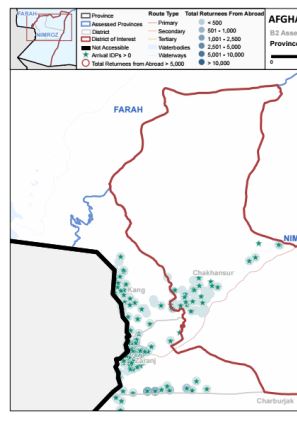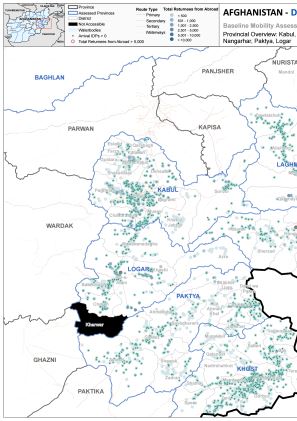-
Countries
-
Data and Analysis
-
Special Focus
-
Crisis Responses
Afghanistan
Afghanistan
IDPs tracked
Displacement Movements
4,394,000
IDMC 2022
Data collection round
About Afghanistan
The Displacement Tracking Matrix (DTM) is an information management system of tools and methodologies used to track and monitor displacement and population mobility. In Afghanistan, IOM activated the DTM programme in January 2017 in response to the substantial increase of Afghans returning home from neighbouring countries, as well as record levels of internal displacement. DTM in Afghanistan is designed to regularly and systematically capture, process and disseminate multi-layered information about the population sizes, locations, geographic distribution, movements, vulnerabilities, evolving multisectoral needs, and the drivers of migration of returnees, IDPs, migrants and mobile populations. DTM implements baseline mobility assessments, flow monitoring, registrations, and various migration surveys to provide an essential evidence base that enables decision-makers and humanitarian, reintegration and development partners to maximize resources and deliver efficient, better-targeted, mobility-sensitive and sustainable humanitarian; reintegration, community stabilization and development programming.
The value-added impact of DTM in Afghanistan is to inform action and results for people in need. DTM Afghanistan implements its activities at both the national and provincial levels. DTM works closely with other (IOM) programmes through referring identified populations in need of assistance at flow monitoring points to IOM’s Cross Border Return and Reintegration, Protection, Humanitarian Assistance, and Reintegration and Development (RADA) programmes. DTM Afghanistan also supports humanitarian partners and clusters, including WFP, FAO, UNHCR, IRC, DRC, NRC, and WHO, among many others, by providing emergency tracking updates in large-scale or sudden onset movements, such as emergency event tracking and drought response. Furthermore, stabilization and development actors, including IOM’s RADA programme, and the World Bank leverage DTM’s information to select priority communities and districts with higher concentrations of IDPs and returnees to receive reintegration and livelihoods assistance and improvements to core infrastructure and essential services. In support of health partners, including WHO, UNICEF, and the Humanitarian Health Cluster, DTM data informs the selection of priority, at-risk districts, border areas, communities, and health facilities in need of strengthened capacity, response, surveillance, and risk education for polio, TB, COVID-19, and other infectious diseases.
Contact
Modher ALHAMADANI
Senior Programme Coordinator - DTM
malhamadani@iom.int
DTM AFGHANISTAN
DTMAFGHANISTAN@iom.int
Current Donors
- Republic of Korea
- Norway
- CERF
- Canada
- Italy
- EU
- FCDO
Afghanistan — District Maps Baghlan (June 2018)
The following maps provide information on the number of returnees from abroad in different districts of the Baghlan Province, Afghanistan.
Sep 25 2018
Afghanistan — District Maps Baghlan (June 2018)
Afghanistan — Baseline Assessment Form (August 2018)
The following document is the baseline assessment form used for the Baseline Mobility Assessments conducted by DTM Afghanistan.
Afghanistan — Baseline Mobility Assessment Summary Results (April—June 2018)
In Afghanistan, DTM employs the Baseline Mobility Assessment tool, designed to track mobility, determine the population sizes and locations of forcibly displaced people, reasons for displacement, places of origin, displacement locations and times of displacement, including basic demographic
Afghanistan — Settlement Maps District Atlas — Takhar (March 2018)
These maps provide details on settlements in each of the 17 districts in the Afghan province of Takhar, as found during DTM's B2 assessment exercise, as of March 2018.
Afghanistan — Settlement Maps District Atlas — Nimroz (March 2018)
These maps provide details on settlements in each of the 5 districts in the Afghan province of Nimroz, as found during DTM's B2 assessment exercise, as of March 2018.
Afghanistan — Settlement Maps District Atlas — Nangarhar (March 2018)
These maps provide details on settlements in each of the 22 districts in the Afghan province of Nangarhar, as found during DTM's B2 assessment exercise, as of March 2018.
Afghanistan — Settlement Maps District Atlas — Paktya (December 2017)
These maps provide details on settlements in each of the 11 districts in the Afghan province of Paktya, as found during DTM's B2 assessment exercise, as of December 2017.
Afghanistan — Settlement Maps District Atlas — Logar (December 2017)
These maps provide details on settlements in each of the 7 districts in the Afghan province of Logar, as found during DTM's B2 assessment exercise, as of December 2017.
Afghanistan — Settlement Maps District Atlas — Laghman (March 2018)
These maps provide details on settlements in each of the 5 districts in the Afghan province of Laghman, as found during DTM's B2 assessment exercise, as of March 2018.
Afghanistan — Settlement Maps District Atlas — Kunduz (March 2018)
These maps provide details on settlements in each of the 7 districts in the Afghan province of Kunduz, as found during DTM's B2 assessment exercise, as of March 2018.
Afghanistan — Settlement Maps District Atlas — Kunar (December 2017)
These maps provide details on settlements in each of the 16 districts in the Afghan province of Kunar, as found during DTM's B2 assessment exercise, as of December 2017.
Afghanistan — Settlement Maps District Atlas — Khost (March 2018)
These maps provide details on settlements in each of the 13 districts in the Afghan province of Khost, as found during DTM's B2 assessment exercise, as of March 2018.
Afghanistan — Settlement Maps District Atlas — Kandahar (December 2017)
These maps provide details on settlements in each of the 15 districts in the Afghan province of Kandahar, as found during DTM's B2 assessment exercise, as of December 2017.
Afghanistan — Settlement Maps District Atlas — Kabul (March 2018)
These maps provide details on settlements in each of the 15 districts in the Afghan province of Kabul, as found during DTM's B2 assessment exercise, as of March 2018.
Afghanistan — Settlement Maps District Atlas — Herat (March 2018)
These maps provide details on settlements in each of the 16 districts in the Afghan province of Herat, as found during DTM's B2 assessment exercise, as of March 2018.
Afghanistan — Settlement Maps District Atlas — Farah (March 2018)
These maps provide details on settlements in each of the 11 districts in the Afghan province of Farah, as found during DTM's B2 assessment exercise, as of March 2018.
Afghanistan — Settlement Maps District Atlas — Baghlan (March 2018)
These maps provide details on settlements in each of the 15 districts in the Afghan province of Baghlan, as found during DTM's B2 assessment exercise, as of March 2018.
Afghanistan — Settlement Maps District Atlas — Balkh (December 2017)
These maps provide details on settlements in each of the 16 districts in the Afghan province of Balkh as found during DTM's B2 assessment exercise, of December 2017.
Afghanistan — Settlement Maps — Baseline Mobility Assessments — Provincial Detail (March 2018)
These fifteen maps provide information on settlements in every of the 15 provinces of Afghanistan, as found during DTM's Baseline Mobility Assessments Exercise conducted between January and March 2018.
Afghanistan — Settlement Maps — Baseline Mobility Assessment — Provincial Overview (March 2018)
These three maps provide an overview of IDP and Returnee settlements in Afghanistan, as found during DTM's Baseline Mobility Assessments conducted between January and March 2018.
Afghanistan — Overview Maps — Total Inflows (IDPs and Returnees) (March 2018)
These two maps provide information on the total inflows of IDPs and Returnees in Afghanistan as of March 2018.
Afghanistan — Overview Maps — Baseline Mobility Assessments (March 2018)
The two maps provide information on IDPs and Returnees gathered during DTM's Baseline Mobility Assessment exercise conducted between January and March 2018.
Afghanistan — Overview Maps — Nomads (March 2018)
These three maps provide information about nomad familiaies and nomad individuals in Afghanistan as of March 2018.
Afghanistan — Overview Map — Returnees from Pakistan and Iran (March 2018)
These two maps provide information on the total number of Afghan returnees from Pakistan and Iran, as well as the number of Afghan returnees by status (documented or undocumented), as of March 2018.
Pagination
Pagination
Pagination
- First page
- Previous page
- 1
- 2
- 3
- 4
- 5

























